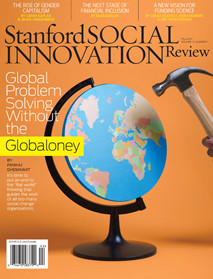When Stanford Social Innovation Review was launched in 2003, one of our guiding principles was the belief that social innovations would arise (in part) from the creative crossing of boundaries by organizations from the nonprofit, for-profit, and government sectors.
Businesses and investors needed to find ways to incorporate a social mission in their strategy and operations, what some now call shared value. Nonprofits needed to find ways to adapt business approaches to solving social problems. And government needed to refashion the way it worked with the for-profit and nonprofit sectors.
Browse the fall 2014 issue.">A decade ago sector crossing was not commonplace. Today, thanks in small part to SSIR’s efforts, this approach to solving social problems is becoming more common. This issue of the magazine is full of articles about these kinds of practices and thinking. Let me point out two articles in particular that are about businesses that have adopted a social mission as an integral part of their work.
Our Case Study, “From Petitions to Decisions,” is an in-depth look at Change.org, one of the most successful mission-driven businesses to have been formed in the past decade. Change.org, which provides a platform for people to create and sign petitions, has more than 70 million registered users and is signing up new ones at the rate of 4 million per month.
Are you enjoying this article? Read more like this, plus SSIR's full archive of content, when you subscribe.
Change.org is an unabashedly for-profit business. The privately held firm is said to have been profitable since 2010. One of the company’s investors is Omidyar Network, a hybrid organization that invests in for-profit mission-driven businesses and makes grants to nonprofit organizations.
Change.org generates much of its revenue from advertisers who want to reach the millions of people who frequent its website. The company has ambitious plans to move beyond petitions to become a platform for a new sort of digital democracy—a place where ordinary people and government officials can come together to discuss ideas and create public policies.
Change.org isn’t the only for-profit business profiled in this issue of SSIR. We also have a story in our What’s Next section, “When the ‘Doves’ Fly,” about Planet Labs, an organization that is launching dozens of small and inexpensive satellites that will orbit and take images of Earth. The company will then sell the images to a variety of clients (think Google Earth).
What makes Planet Labs interesting to SSIR readers is that even though the company is still a start-up and just getting off the ground, it has already formed a sister organization, Planet.org, designed to help nonprofits find ways to use the images. The possibilities for using satellite images are numerous—tracking the deforestation of jungles, examining the destruction caused by typhoons, and monitoring the mass migrations of people caused by war and civil conflict.
Some nonprofits are already working with other satellite firms and doing these sorts of things, but the images are often old, making them less useful in tackling problems as they happen. Planet Labs’s goal is to provide daily updates of images, which will make them much more useful. Change.org and Planet Labs are just two of many businesses that are beginning to use the power of capitalism to make the world a better place.
Support SSIR’s coverage of cross-sector solutions to global challenges.
Help us further the reach of innovative ideas. Donate today.
Read more stories by Eric Nee.


